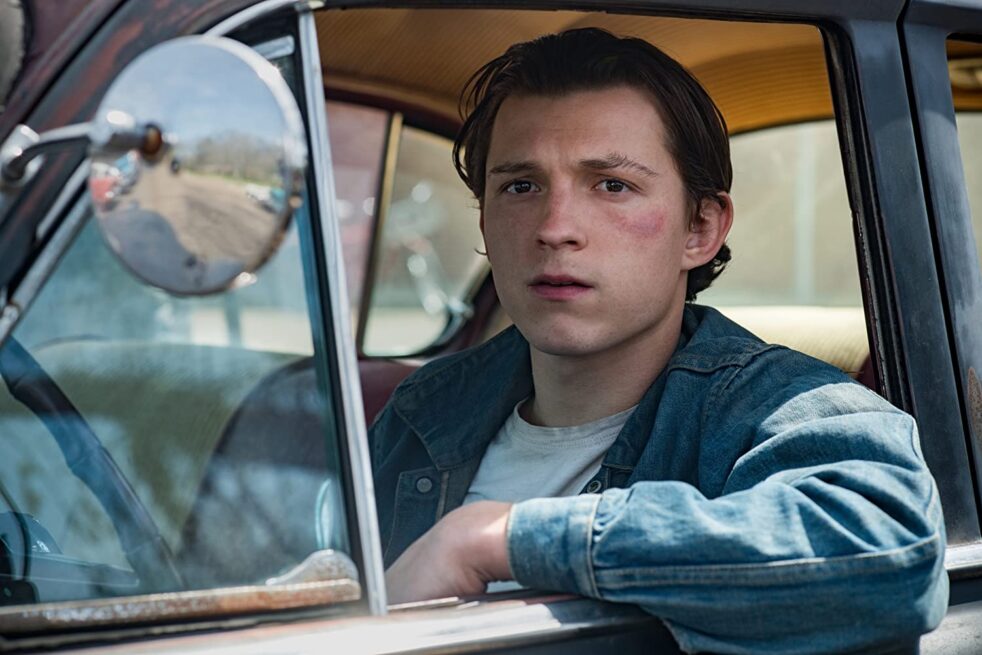Our Take: 2/5 Stars
Netflix’s latest star-studded film, “The Devil All the Time,” directed and co-written by Anthony Campos (“Afterschool”) and based on Donald Pollock’s novel of the same name, is a sinister take on the Southern Gothic tradition.
Set in the deeply religious towns of Knockemstiff, Ohio and Coal Creek, West Virginia, the film follows a colorful cast of characters — a World War II veteran and his family, a serial-killing couple, a corrupted police officer, and a few degenerate Bible-thumpers — across decades of bloodshed, lust, and misery.
The film is the latest in a spate of beautifully-made and stunningly-acted Netflix films that fall short due to hiccups in the plot and storytelling. The opening scene finds Willard Russell (Bill Skarsgård, “IT”), a U.S. soldier in the Solomon Islands, discovering the crucified body of a fellow soldier.
The gruesome religious imagery haunts Willard — and the film — for the rest of his life. He goes on to marry, settle down in Knockemstiff, and have a son named Arvin. But misery does not stay away for long.
When sickness comes to the Russell household, Willard’s already feverish religious devotion turns maniacal.
Starting at the 45 minute mark, the film focuses on Arvin, played by Tom Holland (“Spider-Man: Homecoming”). Now a young man living with his grandparents, Arvin has inherited a violent temperament and deep-rooted trauma from his father. Despite this, he harbors great affection for his found family in Coal Creek and specifically his adopted sister, Lenore (“Eliza Scanlen, “Little Women”). But Arvin can’t outrun the sort of macabre events that shaped his childhood. Trouble arrives in the form of Preston Teagardin, a charismatic new Reverend played to subtle, scummy perfection by Robert Pattinson (“Tenet”).
Behind Teagardin’s magnetism and religious fervor bubbles depravity and perversion, as Arvin soon learns. Forced to come to terms with the undoing of his family and the evil around him, Arvin reacts in the only way he knows how — with violence.
Willard and Arvin both cross paths at different times with other characters, who in turn weave in and out of each other’s lives, most often for the worse. The merit of the film rests largely on the shoulders of two superheroes: Tom Holland, darling of the Marvel Cinematic Universe and Robert Pattinson, DC’s latest Batman. Holland brings sensitivity, compassion, and keen intensity to a character that might, in less skilled hands, have been just as despicable as the rest. The remarkable expressivity and emotional range that Holland is known for are on full display in “The Devil All The Time,” and his Arvin is one that you root for and sympathize with despite everything.
Opposite Holland is Pattinson as one of the most abominable characters in film rife with abomination. Pattinson’s lascivious, despicable Reverend Teagardin makes the viewer’s skin crawl, complete with a pointy
Southern twang.
Arguably the best scenes in the film are the ones between Pattinson and Holland, where every glance and every movement are heavy with significance and the tension is near unbearable, complemented by Campos’s meticulous shots.
Both Holland and Pattinson prove the range of their abilities, far beyond the stereotypes that made them famous. Both demonstrate new breadth and new depth; and both can not seem to stop outperforming themselves.
Despite masterful performances by Holland and Pattinson and notable appearances by Bill Skarsgard, Riley Keough, Sebastian Stan, Eliza Scanlen, and Harry Melling, “The Devil All the Time” ultimately disappoints. At the end, the viewer is left wondering what the point of it was.
At just over two hours, it simply is not long enough to flesh out the stories of such a tangled knot of characters. By the time the credits roll, there are more questions left than answers. One might even wonder why most of those characters are in the story at all — it seems that their only purpose was to add another level of filth and iniquity to an already sordid plot.
The film portrays the long shadow cast by war, the passing on of generational trauma, and the abuse of power by organized religion; it uncovers the muck and grime beneath the surface of Southern congeniality.
But in the end, it offers no redemption — not for its characters, and not for their wanton bloodshed, lechery and monstrosity. The only character who gets any sort of vindication is Arvin, and one can hope he has finally broken out of the cycle of violence perpetuated by his family, his surroundings, and himself. But that is not enough.
The most obvious theme of the film is the misuse of organized religion and specifically Christianity by those who would twist it to their own ends. Some of the evilest, most crazed characters are men of faith: Preston Teagardin, Roy Laferty, Willard Russell. Their hair-raising sermons, impassioned calls upon the Lord and blood-curdling deeds all warn of religion in the hands of men — or men in the hands of religion.
In the end, the viewer is left to question if God had a hand in their sins, or if it really was the devil all the time.
